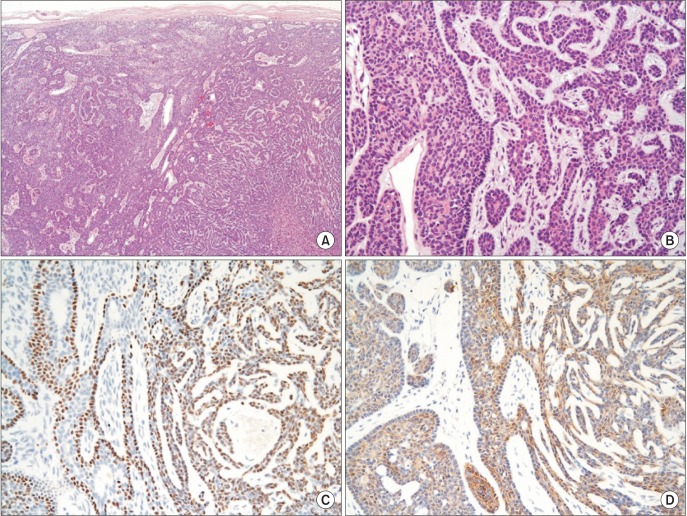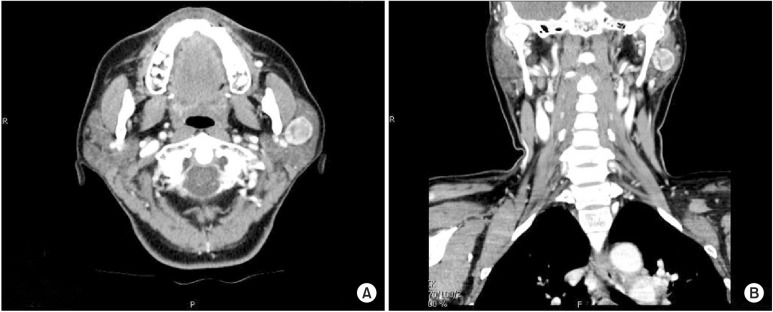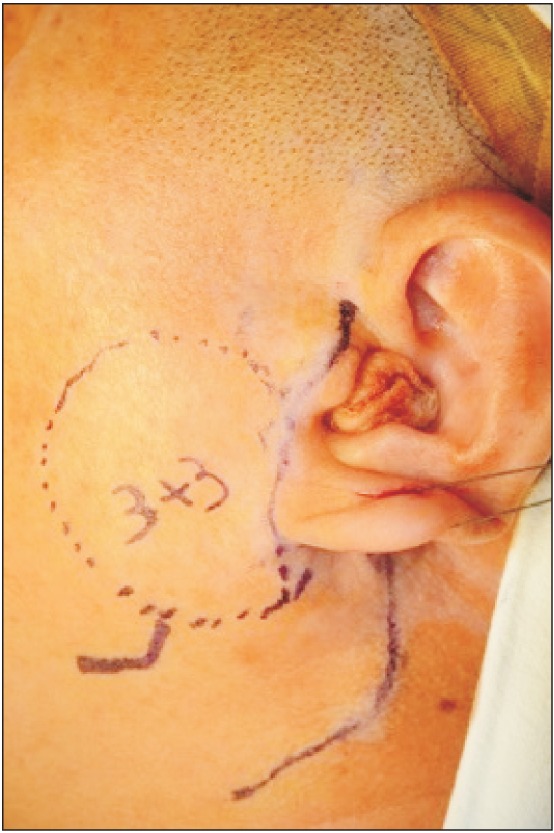1. Vicandi B, Jiménez-Heffernan JA, López-Ferrer P, González-Peramato P, Patrón M, Viguer JM. Fine needle aspiration cytology of basal cell adenoma of the salivary gland: a cytohistological correlation study of 35 cases. Cytopathology. 2012; 23:315–319. PMID:
21838722.

2. Nakabayashi M, Shomori K, Kiya S, Shiomi T, Nosaka K, Ito H. Tubular-trabecular type basal cell adenoma of the parotid gland: a patient report. Yonago Acta Med. 2010; 53:65–69. PMID:
24031120.
3. González-García R, Nam-Cha SH, Muñoz-Guerra MF, Gamallo-Amat C. Basal cell adenoma of the parotid gland: case report and review of the literature. Med Oral Patol Oral Cir Bucal. 2006; 11:E206–E209. PMID:
16505803.
4. Wasson J, Karim H, Yeo J, Panesar J. Cervicomastoidfacial versus modified facelift incision for parotid surgery: a patient feedback comparison. Ann R Coll Surg Engl. 2010; 92:40–43. PMID:
20056059.

5. Saha S, Pal S, Sengupta M, Chowdhury K, Saha VP, Mondal L. Identification of facial nerve during parotidectomy: a combined anatomical & surgical study. Indian J Otolaryngol Head Neck Surg. 2014; 66:63–68. PMID:
24605304.
6. Kudoh M, Harada H, Sato Y, Omura K, Ishii Y. A case of basal cell adenoma of the upper lip. Case Rep Med. 2014; DOI:
10.1155/2014/795356.

7. Chaudhry AP, Cutler LS, Satchidanand S, Labay G, SunderRaj M. Ultrastructure of monomorphic adenoma (ductal type) of the minor salivary glands. Arch Otolaryngol. 1983; 109:118–122. PMID:
6849665.

8. Fantasia JE, Neville BW. Basal cell adenomas of the minor salivary glands: a clinicopathologic study of seventeen new cases and a review of the literature. Oral Surg Oral Med Oral Pathol. 1980; 50:433–440. PMID:
6935599.
9. Kim CW, Kim SG. Basal cell adenoma misdiagnosed as an adenoid cystic carcinoma in the parotid gland. J Korean Assoc Oral Maxillofac Surg. 2012; 38:314–317.

10. Nagao K, Matsuzaki O, Saiga H, Sugano I, Shigematsu H, Kaneko T, et al. Histopathologic studies of basal cell adenoma of the parotid gland. Cancer. 1982; 50:736–745. PMID:
6284339.

11. Ogawa I, Nikai H, Takata T, Miyauchi M, Ito H, Ijuhin N. The cellular composition of basal cell adenoma of the parotid gland: an immunohistochemical analysis. Oral Surg Oral Med Oral Pathol. 1990; 70:619–626. PMID:
2234882.

12. Yu GY, Ubmüller J, Donath K. Membranous basal cell adenoma of the salivary gland: a clinicopathologic study of 12 cases. Acta Otolaryngol. 1998; 118:588–593. PMID:
9726688.
13. Junquera L, Gallego L, de Vicente JC, Fresno MF. Bilateral parotid basal cell adenoma: an unusual case report and review of the literature. J Oral Maxillofac Surg. 2010; 68:179–182. PMID:
20006174.

14. Olsen KD, Moore EJ. Deep lobe parotidectomy: clinical rationale in the management of primary and metastatic cancer. Eur Arch Otorhinolaryngol. 2014; 271:1181–1185. PMID:
23832259.

15. Kidd HA. Diseases of the parotid gland and the Frey syndrome. Br J Hosp Med. 1969; 2:1513–1522.
16. Laccourreye H, Laccourreye O, Cauchois R, Jouffre V, Ménard M, Brasnu D. Total conservative parotidectomy for primary benign pleomorphic adenoma of the parotid gland: a 25-year experience with 229 patients. Laryngoscope. 1994; 104:1487–1494. PMID:
7990639.
17. Gaillard C, Périé S, Susini B, St Guily JL. Facial nerve dysfunction after parotidectomy: the role of local factors. Laryngoscope. 2005; 115:287–291. PMID:
15689752.






 PDF
PDF ePub
ePub Citation
Citation Print
Print






 XML Download
XML Download